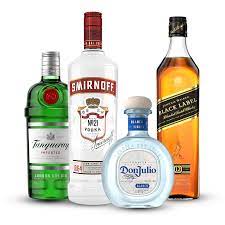Rum has been a popular alcoholic beverage for centuries and is enjoyed by many around the globe. Not only can it be enjoyed neat, but mixed with other ingredients helps bring out its flavour even more.
One of the most common distinctions between rum is between white rum and dark rum. As the colours suggest, these two types of rum produce different flavour profiles, making them better suited for certain recipes or simply how you enjoy them.
So if you’re looking to educate yourself in all things rum-related, let us fill you in on everything there is to know about white and dark rum!
Table of Contents
Dark or White: Which is a Better Rum?
When it comes to rum, there is an age-old debate about which type is best: dark or white. While there may be no definitive answer regarding the superior variety of rum, some factors can help you determine what kind might suit your tastes better.
Dark rum has a more intense flavour due to its ageing process, ranging from one year to 15. During the ageing process, dark rum is typically stored in oak barrels, giving it a distinct flavour that is characterised by notes of spice and caramel. It also has a higher alcohol content than white rum, typically up to 40 per cent ABV (alcohol by volume).
White rum, on the other hand, is made from fermented and distilled molasses or sugar cane juice. It is then filtered to remove its colour, giving it a lighter flavour that tends to be sweeter and more subtle than dark rum. White rum also typically has a lower ABV than dark rum (around 35 per cent).
Ultimately, the preference between dark or white rum boils down to personal taste. If you like the smoky and intense flavour of dark rum, then that would be the better choice for you. But, if you prefer a lighter and sweeter spirit, then opt for white rum.
What is Dark Rum?
Dark rum, also known as black rum, is a variety of rum that has been aged in oak barrels for a longer period than light or gold rum. This ageing process gives dark rum a richer flavour and deeper colour than lighter varieties.
During the ageing process, some of the sugar used to distil the spirit evaporates, resulting in higher alcohol content. Dark rum is often used in cocktails, mixed drinks and desserts due to its unique flavour profile. It is also a common ingredient in many Caribbean dishes, such as jerk chicken and fish stew.
Dark rum has a distinct flavour that sets it apart from light or gold rums and can be enjoyed on the rocks, mixed with cola or fruit juices, or as a cooking ingredient. Dark rum can also be used in hot drinks such as coffee and hot chocolate.
What is White Rum?
White rum is a type of rum that has been aged for approximately one year or less. It is filtered and light-bodied, making it palatable to many drinkers.
White rum can be enjoyed neat, on the rocks, mixed with fruit juice, in cocktails, or as an ingredient in baking recipes. Its light taste makes it versatile enough to be used in various recipes.
White rum also has a subtle sweetness that makes it an excellent mixer for cocktails. The subtle sweetness and light body make it an ideal spirit for sipping on its own or as part of a cocktail.
How Do They Differ?
Base Constituent
While they come from the same source, sugar cane, their base constituents are quite different.
Dark rum has a strong molasses flavouring due to being distilled with blackstrap molasses. This gives it its distinctive dark colour as well as its characteristic sweetness and richness of flavour. White rum, on the other hand, is distilled from sugar cane juice and is much lighter in colour, and has a milder taste.
Colour
Dark and white rum differ primarily in colour; dark rums tend to be darker, richer colours such as mahogany and black, while white rums are typically golden-hued.
Dark rums are more full-bodied than their lighter counterparts and tend to have a slightly higher alcohol content. They also feature deeper, more complex flavour profiles that range from smoky and woody to sweet and spicy; white rums, on the other hand, are lighter in flavour and generally have a sweeter taste.
Ageing Period
Dark rum and white rum are both popular types of rum, but they differ in the ageing period. Dark rums are aged longer than white rums, typically for two years or more. The ageing process gives dark rum its distinctive flavour and colour, which is usually much darker than that white rum. During the ageing process, the rum is exposed to oxygen, which helps the spirit gain complexity and smoothness.
Production Process
Dark and white rum differ in the production process and the end product. Dark rum is made from molasses, a byproduct of sugarcane. It is fermented and distilled until it is a dark, sweet liquid. This process produces a heavier-bodied spirit with notes of spices, caramel, and smoke. This rum is usually aged in oak barrels, giving it a fuller flavour profile and more complexity.
White rum, on the other hand, is made from sugarcane juice. It is distilled at a higher proof than dark rum, making it less sweet and giving it a lighter flavour profile with notes of grassiness and sweetness. White rum is usually unaged, but some brands will age it in oak barrels for up to six months to give it a deeper flavour.
Barrel Type
Dark rum is made by ageing the spirit in charred oak barrels. This process imparts a deep, rich flavour and aroma to the rum, making it a favourite among drinkers who prefer more full-bodied beverages.
White rum, on the other hand, is aged in stainless steel or charred oak barrels. As a result of this different barrel type, white rum has a lighter flavour and aroma than its darker counterpart.
Flavour & Taste
Dark rum has a strong, robust flavour and an intense aroma. Its colour is typically deep brown or black due to the addition of caramelised sugar or molasses during the production process. It has a richer taste with notes of spices like cinnamon, nutmeg and cloves, as well as hints of oak, smoke and tobacco. Dark rums often age longer, giving them a more complex flavour.
White rum has a light and smooth taste with subtle hints of sweetness from the cane sugar used to make it. It is usually crystal clear, although some brands may add caramel colouring to give it a golden hue. Its flavour profile is typically less intense than dark rum, making it more suitable for cocktails. White rum is also aged for a shorter period than dark rum, giving it a fresher taste and a lighter body.
Usage
Dark rum is often used in cooking and baking due to its rich flavour. Its distinct taste can add depth and complexity to certain dishes, like seafood recipes or desserts. It’s also popular for sipping neat or on the rocks and mixing cocktails like a Dark & Stormy or Daiquiri.
White rum, on the other hand, is usually preferred for cocktails. Its light taste and easy mixability make it ideal for drinks like a Mojito or Piña Colada. It also works great in fruity summer drinks and refreshing punches. White rum can be sipped neat or on the rocks, but its flavour will not stand out as much as dark rum. Add white rum to a delicious concoction to get the most out of white rum.
Choosing the Right Rum for you
As you can see, there are a few key differences between white rum and dark rum. White rum is typically lighter and has a milder flavour, while dark rum is darker in colour and has a richer flavour.
The type of rum you choose will ultimately depend on your personal preferences. Do you prefer the light, crisp taste of white rum? Or do you like the bolder flavour of dark rum? Try both types of rum and see for yourself!











